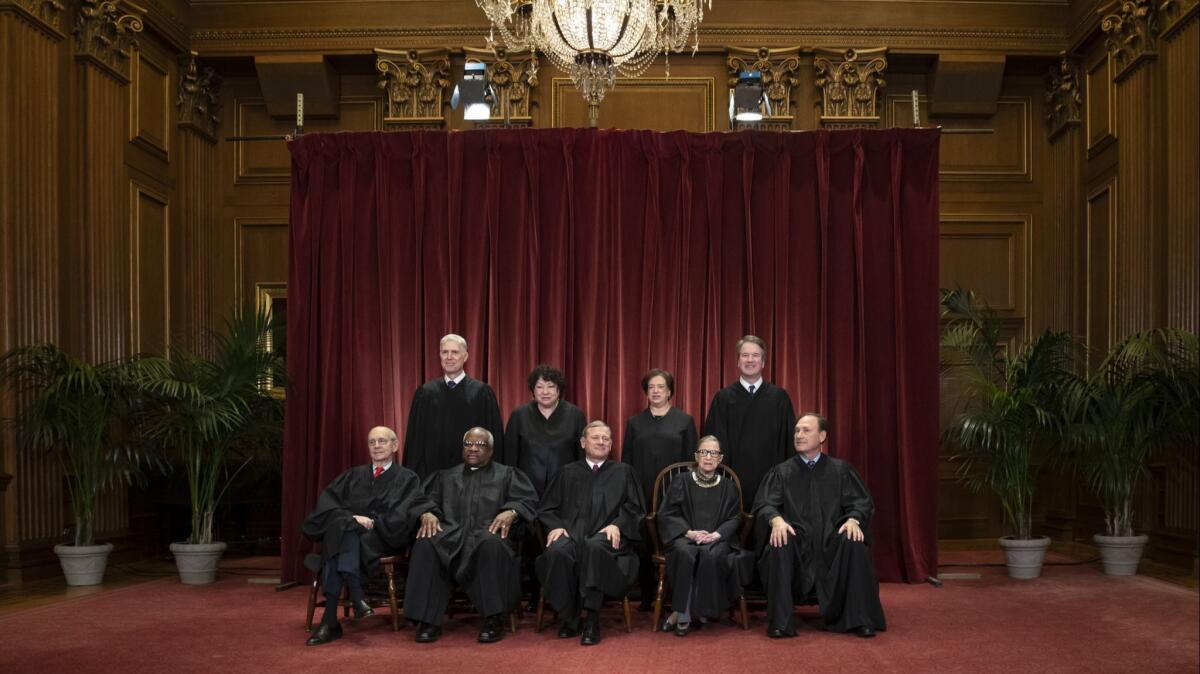Op-Ed: Trust in the justices of the Supreme Court is waning. Here are three ways to fortify the court

The Supreme Court has taken some serious hits to its reputation for independence and impartiality in these polarized times.
Since the death of Justice Antonin Scalia, the Senate confirmation process has produced a series of power plays that have led ordinary Americans to wonder whether the justices can function as legitimate arbiters in our system of checks and balances. Without fundamental reform, each new contested nomination to the court will generate yet another wave of popular alienation.
At the same time, the court has dramatically reduced the number of its judgments on the merits. In 1970, it decided 250 cases; in 2016, 75. The reason is straightforward. The court has been overwhelmed by the problem of docket management. During the same period, the number of petitions for review has almost doubled, from 4,000 to 7,500.
Two seven-justice chambers would mean that more cases could be heard and decided.
The justices and their clerks are investing an extraordinary amount of time identifying the cases that deserve full consideration. This means they cannot review many lower court judgments even when different appellate panels disagree on major issues of constitutional or statutory interpretation. Increasingly, your fundamental rights depend on whether you live in New England’s 1st Circuit or the South’s 5th Circuit or the West’s 9th Circuit.
Systematic reform is required if the court is to function as a modern and effective guardian of uniform law for all Americans in the 21st century.
First, we need more justices, with more focus. One proven solution comes from Germany. Its high court is composed of two chambers of seven members each, with the two chambers reviewing appeals in different subject matter areas. In the American context, it would make the most sense for one chamber to address questions of statutory interpretation; the other, constitutional issues. In the case of major crises, both chambers would join together to speak with one voice.
Two seven-justice chambers would mean that more cases could be heard and decided. More intensive Supreme Court scrutiny would deter courts of appeals from advancing competing, dramatic departures from “settled law”; they’d know they stood a good chance of a reversal. This would cut down on regional disparities that betray our commitment to equal protection under the law.
The two-chamber solution would require the president and Senate to appoint five new justices. The next challenge is to prevent the president and Senate from abusing this power.
One simple safeguard would be to return the Senate to its old “advice and consent” rules by insisting on 60 votes for confirmation of nominees. This number was reduced to only 51 votes to smooth the path for Justice Neil M. Gorsuch’s ascent to the court. Returning to a supermajority would force the president to nominate justices who can gain the support of centrists of both parties; otherwise, he or she could not hope to fill the new positions or vacancies as they open up over time.
Restoring the 60-vote standard would reshape the politics of judicial selection. So would the last reform I’m going to suggest: term limits.
Justices could be appointed for life, but their service on the high court would be limited to 14 years, and then they would move to the courts of appeals. Term limits eliminate the temptation to stack the court with younger and younger justices, thereby extending for decades the impact of the presidents and senators who first got them appointed. A fixed term would instead encourage the selection of mature jurists who have already marked themselves out by decades of distinguished service to their country.
None of these reforms requires a constitutional amendment. They are all within Congress’s power to implement.
The two-chamber initiative respects the Constitution’s requirement that there shall be “one supreme court” because it would explicitly authorize all 14 justices to convene in joint sessions to rule on matters of the highest importance.
Enter the Fray: First takes on the news of the minute from L.A. Times Opinion »
While the Constitution guarantees justices tenure for life, it nowhere states that they must serve their entire term on the Supreme Court. Nothing prevents Congress from limiting the justices’ service to 14 years and then providing them with a position on an appellate court for the rest of their lives. Justice Sandra Day O’Connor followed this path when she resigned from the court in 2006; her service shows how effective such a design can be.
The Constitution, however, does impose a fundamental limit on the scope of reform. The 14-year term limit would apply only to future nominations. All current members were appointed for life and the Constitution allows their removal solely for lack of “good behavior.”
As to requiring 60 votes for confirmation, the Senate reduced this requirement just a year ago; it can change it back again.
This time around, the new rule should expressly state that only a super-supermajority — three-quarters of the Senate — can lower the barrier in the future.
President Trump won’t take the need for court reform seriously, but the incoming Congress can and must. Otherwise, there will be no stopping the escalating political partisanship that will predictably destroy the court’s legitimacy in the coming decade.
Bruce Ackerman is professor of law and political science at Yale University. His new book, “Revolutionary Constitutions,” will be published in April.
Follow the Opinion section on Twitter @latimesopinionand Facebook
More to Read
A cure for the common opinion
Get thought-provoking perspectives with our weekly newsletter.
You may occasionally receive promotional content from the Los Angeles Times.






